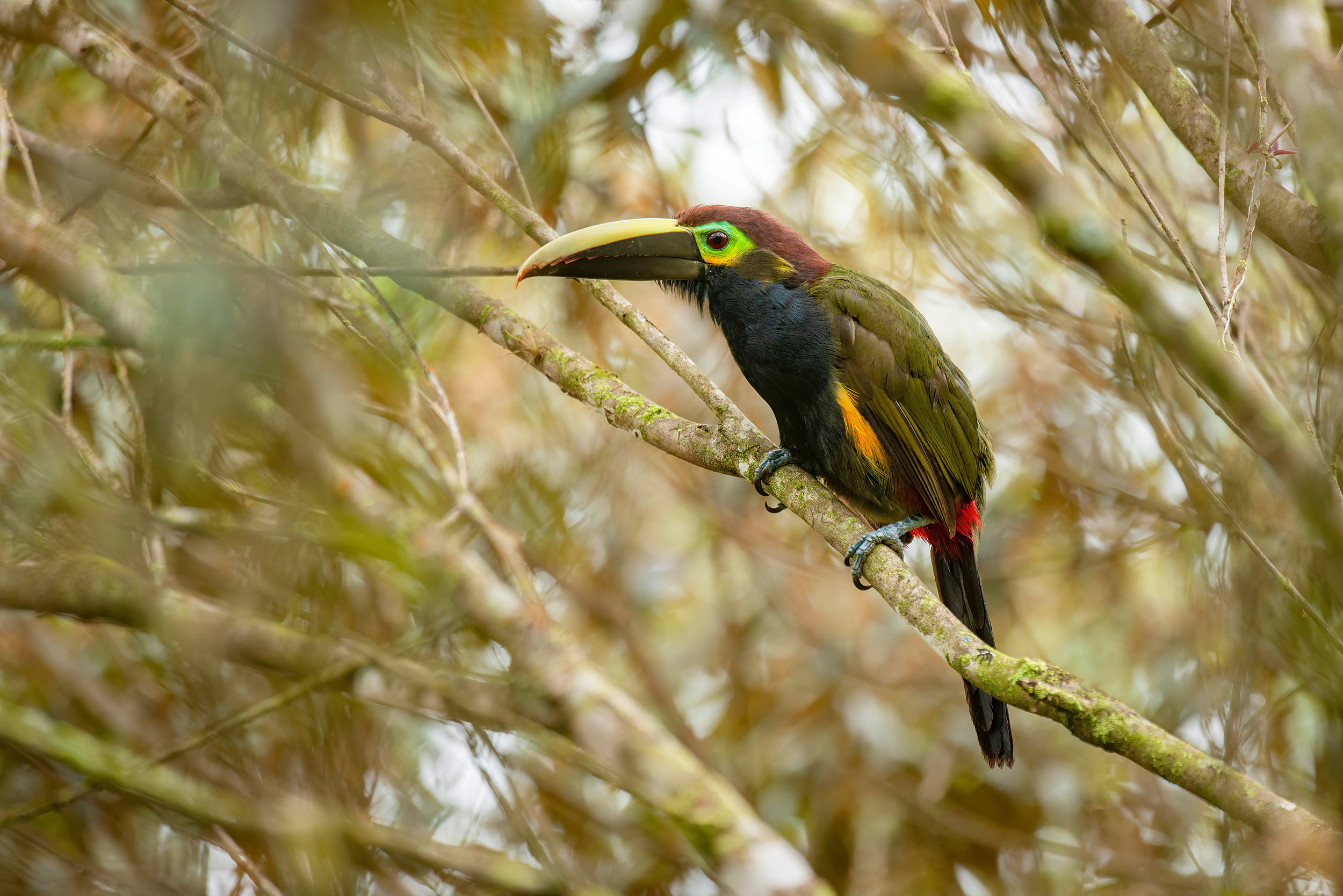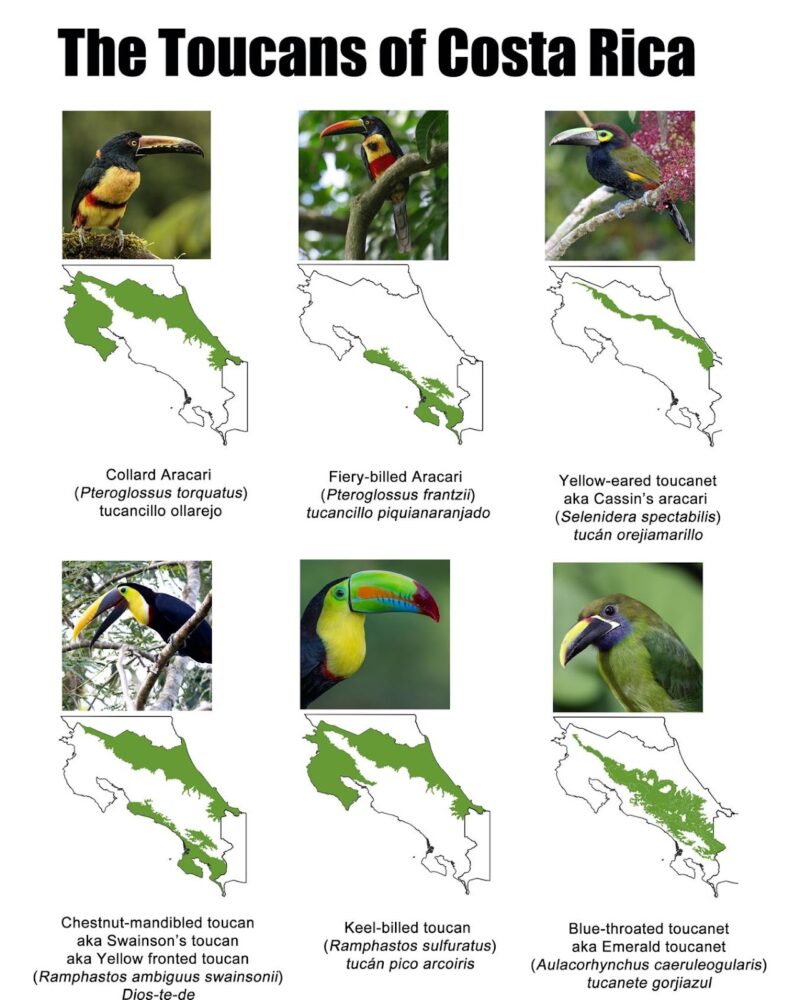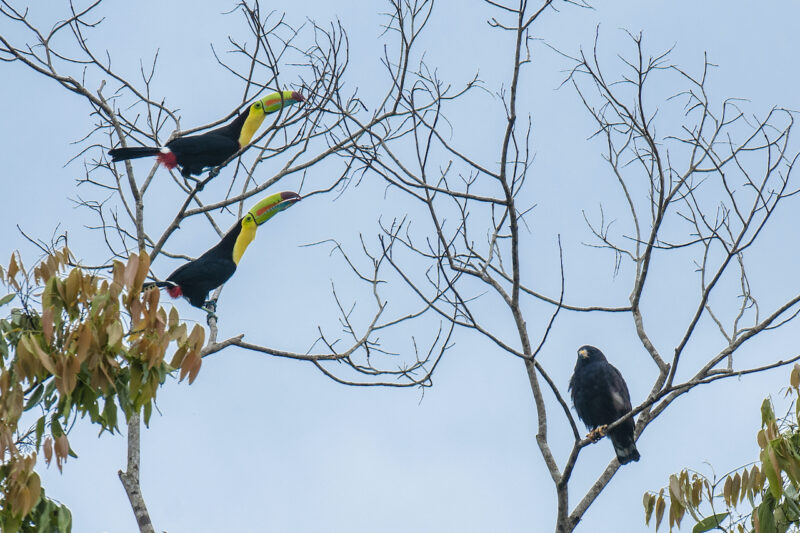Toucans of Costa Rica

Usually, visitors want or would love to see any of these beautiful, exciting and colourful birds, the toucans. In Costa Rica, we have 6 species with the unmistakable outline of a toucan with a dramatic bill projecting far out in front though technically two of them are toucanets and two other aracari.

Toucans are indeed restricted to tropical realms and occur from tropical forests in Mexico south to northern Argentina. Although they are absent from Caribbean Islands, several toucan species range in cloud forest, rainforest, and tropical savannah habitats.
In general, toucans are very social birds that occur in pairs or small flocks. They nest in tree cavities and use their large beaks to eat fruit, insects and many other small creatures, including eggs and nestlings of other birds. They act somewhat like jays and crows, often call from high perches, and are often found at fruiting trees.
Yellow-throated Toucan (Ramphastos ambiguus)
A conspicuous and large bird with an oversized bill. Mainly black, with a yellow throat and face. Note bicolour bill: half dark, half yellow. Found in pairs or small flocks, often parading through the canopy in search of fruit. Sometimes perches very conspicuously on top of a tree. It prefers wooded areas, but can also be found in gardens and borders. Its vocalization helps distinguish it from similar species in some parts of its range.
They nest in existing tree holes (often abandoned by woodpeckers) because their beaks are not strong enough to hammer through the wood. Babies hatch just two weeks after the eggs are laid. They are mainly frugivores and will protect mini-territories consisting of a few branches in a tree where the fruit is ripening. Males sometimes generously contribute their leftovers to their mates by leaving a good feeding spot when she arrives. when they are also opportunistic and will eat frogs, lizards, insects, baby birds and eggs to supplement the fruits.
Keel-billed toucan (Ramphastos sulfuratus)

Large and unmistakable toucan, its bill is huge and with rainbow colours. Usually seen in pairs, but not in groups like toucanets. Flies with a few flaps followed by a slightly swooping glide, sometimes high above the canopy. It looks like a flying banana. He is heard more than he is seen. Their song can go very far and is a repeating frog-like croak. Despite its large size and bright colours, it can be difficult to see through the canopy, where it moves in search of food.
They are the clowns of the bird kingdom and can be seen playing with their food on the treetops. Not only is it common to see them tossing a small fruit in the air and catching it themselves but they’ll also toss one up for their neighbour like teenagers with popcorn. They cram an extended family or small flock into one or two nest holes and are constantly tumbling and sword-duelling with their oversized beaks.
Fiery-billed Aracari (Pteroglossus frantzii)
These are medium-sized, rather slender, long-tailed toucans. Fiery-billed is distinctive: the upper half of the bill is bright orange. Also, note the red belly band. It is more frequently found in small flocks; prefers any type of wooded area including borders and gardens.
This specie tends to be seen from Central Pacific all the way down to the South up to the mid-elevations of the central mountain range.
Collared Aracari (Pteroglossus torquatus)
Small attractive toucan of lowland tropical forests and their edges. Usually found in small groups moving through the canopy of fruiting trees, or maybe seen flying singly across clearings or from tree to tree. It flies direct and fast, this is where its long and distinctive bill and tail can be distinguished. Note the yellow body with black and yellow markings, as well as the serrated pattern on the bill.
The Collared are in the Caribbean and across the north through Guanacaste and the Nicoya peninsula.
Northern Emerald-Toucanet (Aulacorhynchus prasinus)
Medium-sized green toucanet of humid tropical forests on highlands and slopes; very locally in some lowlands. Usually in pairs or small groups moving through the canopy or feeding on fruiting trees. There are no similar birds in its range. Note the tan tail tips, more visible from below. The black and yellow colour pattern on the bill varies from region to region.
The blue and green Costa Rican variety of the Emerald toucanet (Aulacorhynchus prasinus) is now considered a separate species – they have been renamed the Blue-throated toucanet (Aulacorhynchus caeruleogularis)
Yellow-eared Toucanet (Selenidera spectabilis)
Small toucan with a distinctive plumage pattern. The male has a black body with a bright yellow cheek patch; also note the olive back and orange patch on the flanks. The female is similar; she is without the yellow cheek patch but still has bright yellow-green skin around the eye. Found in the forest canopy, usually in pairs or small family groups. Feeds on fruit and sometimes conspicuously perches.
